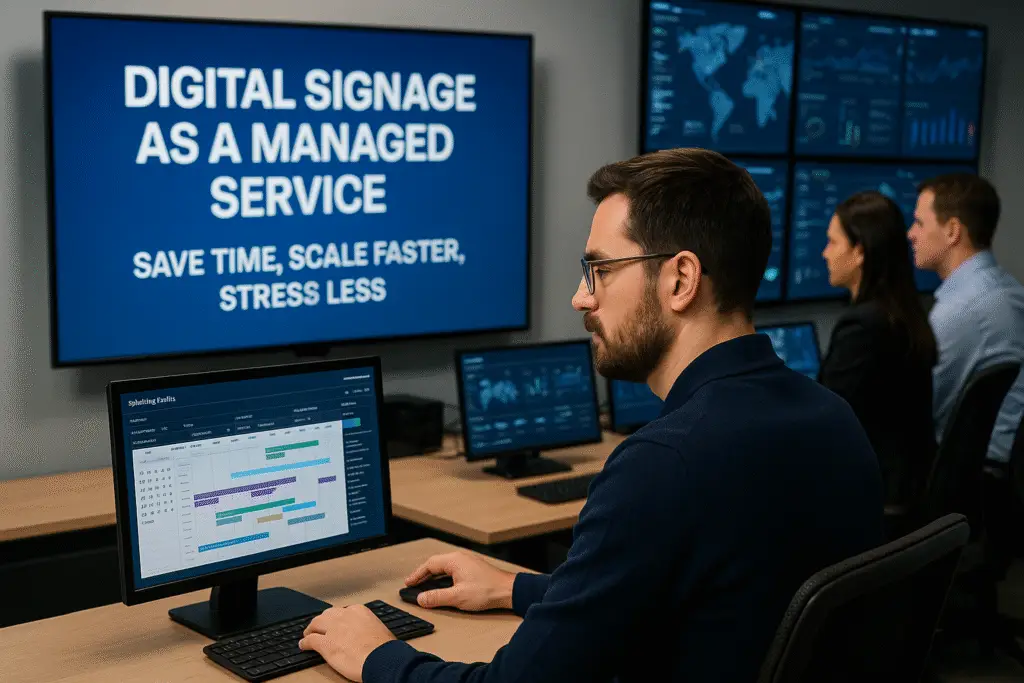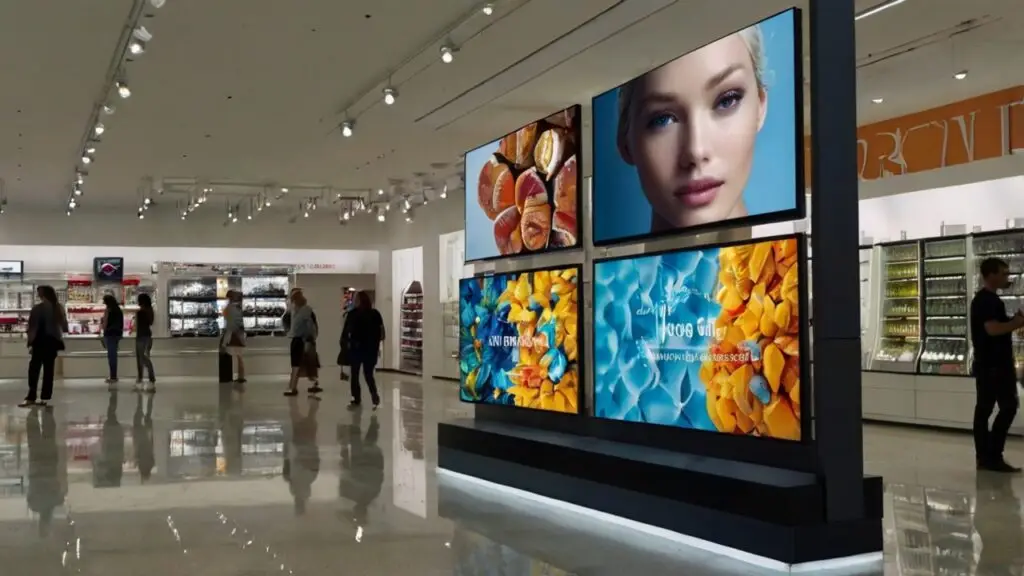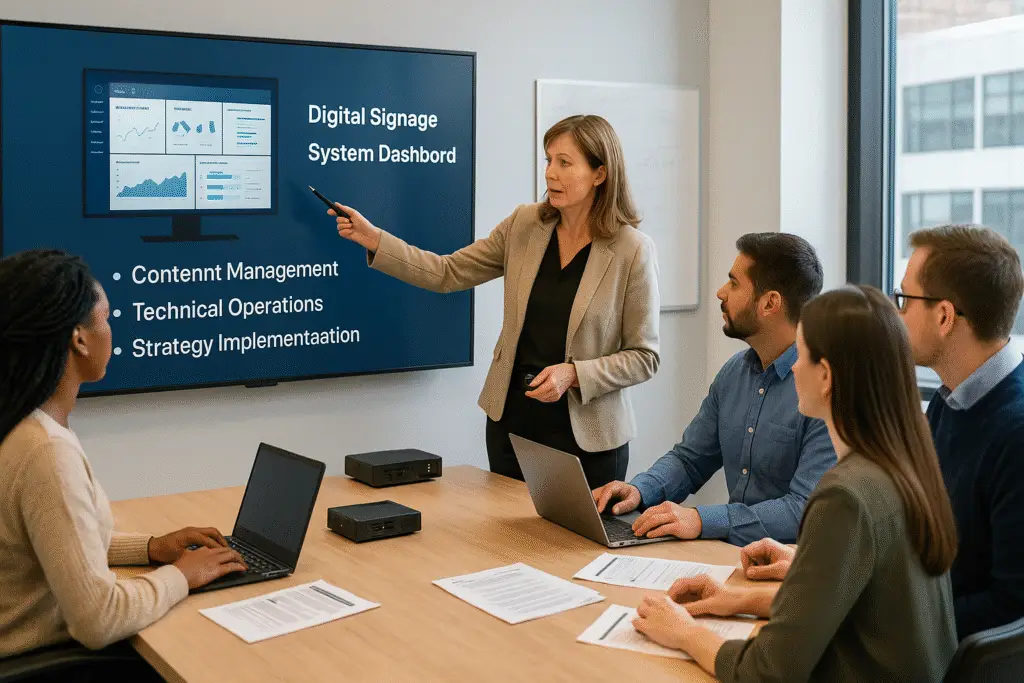Let’s be honest: managing digital signage in-house can get messy fast. Between hardware headaches, scheduling snafus, and content chaos, even the most well-intentioned teams can find themselves buried in updates, outages, and tech support tickets. Enter: digital signage as a managed service. It sounds fancy, but it’s basically the signage version of “set it and (mostly) forget it.” Instead of juggling everything yourself, you hand off the heavy lifting to experts who live and breathe screen networks.
So, what exactly is a managed signage service, what do you get out of it, and is it the right move for your business in 2025? Let’s break it down—no buzzwords, no fluff, just real talk.
First, What Does "Managed Service" Actually Mean?
In the digital signage world, a managed service means outsourcing part or all of your signage operations to a third party. That provider takes care of everything—or at least everything you don’t want to deal with.
Depending on the package, that can include:
- Hardware procurement and installation
- CMS setup and customization
- Content creation or curation
- Scheduling and publishing
- Network monitoring and uptime support
- On-call troubleshooting
- Software updates and patches
Think of it like hiring an IT department specifically for your screens. You still own the vision and the message, but the day-to-day execution? That’s someone else’s job.

Why More Businesses Are Choosing Managed Services in 2025
If you’ve ever tried to roll out signage across multiple locations, you know the pain. Different screen types and different internet setups. Different people uploading Comic Sans PowerPoints to the lobby display. (We see you, Karen in Accounting.)
Here’s why more businesses—especially multi-location retailers, schools, healthcare systems, and corporate offices—are leaning on managed services:
1. Less Stress, More Focus
Your team can focus on what they do best while signage pros handle tech support, scheduling, and optimization. No more wasted afternoons troubleshooting HDMI ports or rebooting media players.
According to recent industry data, businesses that use digital signage managed services report up to 35% less perceived stress related to their visual communications strategy. That’s a significant chunk of headache you can eliminate while improving productivity by as much as 25%.
2. Predictable Costs
Most managed services are subscription-based, so you know exactly what you’re paying each month. It’s a lot easier to budget for than sporadic emergency fixes and unexpected hardware replacements.
A typical managed service contract might cost 15-25% more upfront than handling everything in-house, but when you factor in the hidden costs of DIY signage (staff time, emergency repairs, downtime losses), the managed route often wins the ROI battle.
3. 24/7 Uptime Monitoring
Good providers will keep an eye on your network at all hours, fixing issues before you even notice them. No more finding out a screen’s been blank for a week because someone unplugged it to charge their phone.
As digital signage increasingly plays a central role in a business’s communication strategy and brand identity, 24/7 prompt and responsive support becomes essential—especially for organizations with lean IT teams and constrained resources.
4. Access to Experts
You don’t need to become a digital signage expert overnight. Your provider brings in folks who know CMS platforms, content strategy, hardware specs, and network architecture inside and out.
This expertise becomes particularly valuable as the technology evolves. In 2025, we’re seeing the rise of AI-powered content management, augmented reality integration, and advanced analytics—all areas where specialists can give you a significant edge.
5. Scalability Without the Stress
Opening new locations or expanding your screen network? Managed services make scaling simple. Just tell them what you need, and they’ll take care of the rest.
For distributed enterprises like national retail brands, healthcare facilities, or college campuses, scaling digital signage through a managed service provider means you can place quality digital screens exactly where your audiences are, when they’re looking for information.
What's Included in a Typical Managed Signage Package in 2025?
Every provider structures things a bit differently, but here’s what’s commonly on the menu in 2025:
Core Services:
- Remote management of all screens
- CMS access and configuration
- Uptime monitoring and alerts
- Basic support (email or phone)
- Regular system updates
Add-Ons (a la carte or bundled):
- Content design and motion graphics
- On-site support and maintenance
- AI-powered content optimization
- Integration with other business systems
- Analytics and performance reporting
Pro tip: always ask for a clear scope of services and SLAs (service level agreements). Some providers promise the moon but only deliver help desk hours from 9 to 5. For a comprehensive breakdown of what digital signage managed services can include, check out DSMS, a provider that specializes in full-lifecycle support.

2025's New Managed Service Features: What's Changed
The managed service landscape has evolved significantly since 2023. Here’s what’s new:
AI-Powered Content Management
In 2025, leading managed service providers are leveraging artificial intelligence to optimize your content strategy. Through machine learning algorithms and real-time data analysis, AI-powered digital signs can adapt content dynamically based on audience demographics, behavior patterns, and environmental factors.
This means your managed service can now:
- Automatically optimize content based on performance data
- Create personalized experiences for different audience segments
- Predict maintenance issues before they cause downtime
- Generate content variations to test what works best
One-Stop Shop for Hardware and Services
The line between hardware providers and managed service companies has blurred. In 2025, many providers offer comprehensive packages that include:
- Hardware procurement and leasing options
- Installation and setup
- Ongoing content management
- Technical support and maintenance
- End-of-life replacement planning
This streamlined approach means you can avoid dealing with 100 different vendors if you have 100 locations—the MSP will coordinate all ordering, installation activities, and provide a single consolidated bill.
Cloud-Based Everything
While cloud management isn’t new, the capabilities have expanded dramatically. Today’s managed service providers offer fully cloud-based solutions that provide:
- Remote access from anywhere
- Automated content scheduling across time zones
- Real-time analytics dashboards
- Instant updates to all connected displays
- Seamless integration with other business systems
Looking for Affordable Managed Services?
Who Should Definitely Consider Managed Services
Let’s not sugarcoat it—this setup isn’t for everyone. But if any of these sound like your situation, managed signage could be a game changer:
- You have more screens than staff to manage them
- Your IT team is already stretched thin
- You don’t have a creative department for content
- You need consistent branding across dozens of locations
- You’re trying to scale fast but want to keep things organized
- You need signage to stay compliant, updated, and error-free
Schools, hospitals, franchises, and enterprise organizations are prime candidates. So are smaller teams that want big-league signage without the big-league overhead.
What It Doesn't Mean
Outsourcing signage management doesn’t mean giving up control. You still own the content, the strategy, and the brand voice. A good managed service provider works like an extension of your team—not a replacement.
You call the shots. They just make sure everything works, looks great, and stays online.
Questions to Ask Before You Commit in 2025
Thinking about going the managed service route? Ask these before signing a contract:
- What CMS platforms do you support?
- Do you offer both remote and on-site support?
- How fast is your typical response time?
- Can I still upload or schedule my own content?
- Do you help with creative or just tech?
- What happens if a screen goes down on the weekend?
- Can you scale with me if I grow?
- How do you incorporate AI and automation into your services?
- What analytics and reporting do you provide?
- How do you handle security and compliance requirements?
If the answers feel vague, run. Transparency is key.
How to Calculate the ROI of Managed Digital Signage
When making your decision, crunch the numbers:
Costs to Consider:
- Monthly or annual managed service fees
- One-time setup or onboarding costs
- Hardware costs (if not included in service)
- Content creation fees (if not handled in-house)
Savings to Factor In:
- IT staff time saved (multiply hours × average hourly rate)
- Reduced downtime (estimate lost business during outages)
- Faster deployment for new locations
- Reduced training costs for internal staff
- Elimination of emergency repair fees
According to MVix’s 2025 Digital Signage Statistics, businesses using digital signage see up to 33% increase in sales, with digital signage reducing perceived wait times by more than 35%. Additionally, 84% of retailers believe digital signage creates more brand awareness compared to traditional channels—benefits that are enhanced with professional management.
Most businesses find that managed services start paying for themselves within 3-6 months, especially when factoring in the opportunity cost of staff time.

Final Verdict: Is It Right for You?
If you want modern digital signage without the internal chaos, a managed service setup might be your new best friend. It’s ideal for growing businesses, distributed teams, and anyone who’d rather focus on messaging than media players.
Not every organization needs it—but the ones that do usually wonder why they waited so long.
And hey, if you’re still not sure? Ask a digital signage consultant (I know a good one).
FAQ
What is digital signage as a managed service?
Digital signage as a managed service means outsourcing the setup, content management, and technical support of your screen network to a third-party provider. Instead of handling everything in-house, you rely on experts to keep your displays running smoothly while you focus on strategy and messaging.
Is managed digital signage worth it for small businesses?
Yes—especially if your team doesn’t have the time or tech expertise to manage screens on top of everything else. A managed service gives you professional-level signage without the overhead of hiring in-house staff or piecing together DIY solutions.
What’s typically included in a managed signage package?
Most packages include CMS setup, content scheduling, remote monitoring, software updates, and technical support. Some providers also offer content creation, on-site installation, and analytics. Always ask for a full breakdown of services before signing a contract.


